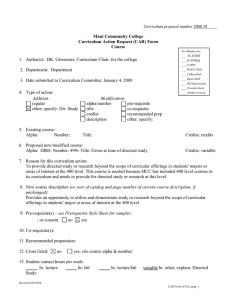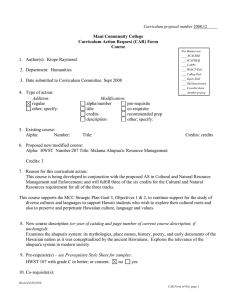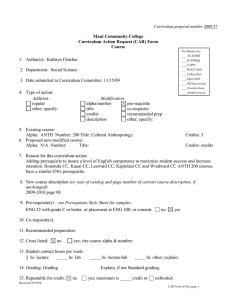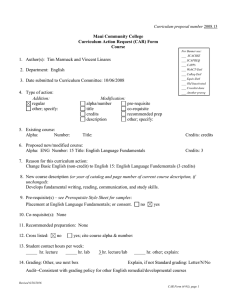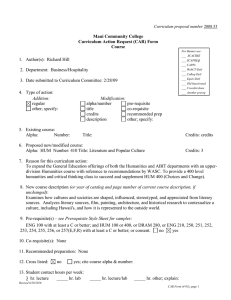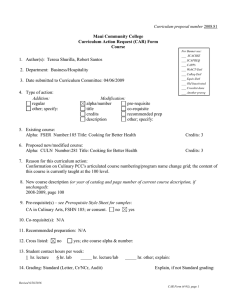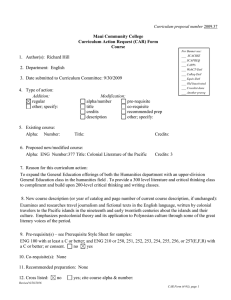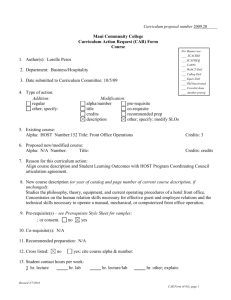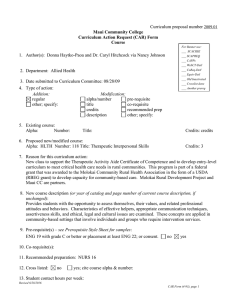Maui Community College Curriculum Action Request (CAR) Form Course
advertisement
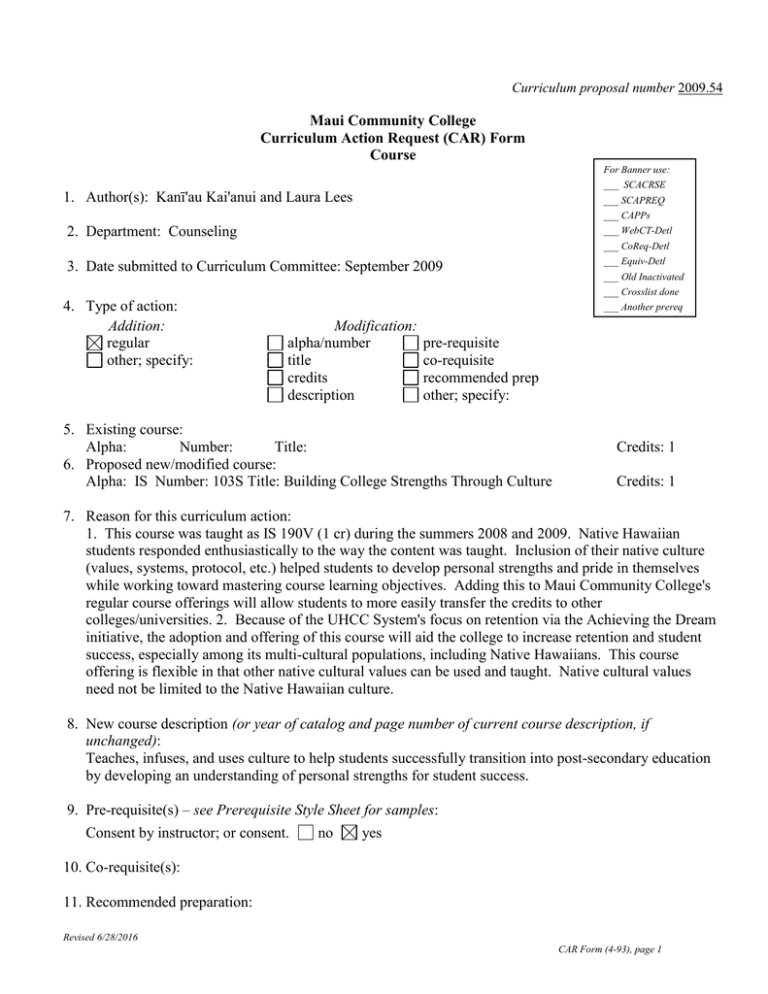
Curriculum proposal number 2009.54 Maui Community College Curriculum Action Request (CAR) Form Course For Banner use: ___ SCACRSE 1. Author(s): Kanī'au Kai'anui and Laura Lees ___ SCAPREQ ___ CAPPs 2. Department: Counseling ___ WebCT-Detl ___ CoReq-Detl 3. Date submitted to Curriculum Committee: September 2009 ___ Equiv-Detl ___ Old Inactivated ___ Crosslist done 4. Type of action: Addition: regular other; specify: ___ Another prereq Modification: alpha/number title credits description pre-requisite co-requisite recommended prep other; specify: 5. Existing course: Alpha: Number: Title: 6. Proposed new/modified course: Alpha: IS Number: 103S Title: Building College Strengths Through Culture Credits: 1 Credits: 1 7. Reason for this curriculum action: 1. This course was taught as IS 190V (1 cr) during the summers 2008 and 2009. Native Hawaiian students responded enthusiastically to the way the content was taught. Inclusion of their native culture (values, systems, protocol, etc.) helped students to develop personal strengths and pride in themselves while working toward mastering course learning objectives. Adding this to Maui Community College's regular course offerings will allow students to more easily transfer the credits to other colleges/universities. 2. Because of the UHCC System's focus on retention via the Achieving the Dream initiative, the adoption and offering of this course will aid the college to increase retention and student success, especially among its multi-cultural populations, including Native Hawaiians. This course offering is flexible in that other native cultural values can be used and taught. Native cultural values need not be limited to the Native Hawaiian culture. 8. New course description (or year of catalog and page number of current course description, if unchanged): Teaches, infuses, and uses culture to help students successfully transition into post-secondary education by developing an understanding of personal strengths for student success. 9. Pre-requisite(s) – see Prerequisite Style Sheet for samples: Consent by instructor; or consent. no yes 10. Co-requisite(s): 11. Recommended preparation: Revised 6/28/2016 CAR Form (4-93), page 1 12. Cross listed: no yes; cite course alpha & number: 13. Student contact hours per week: 1 hr. lecture hr. lab hr. lecture/lab 14. Grading: Standard (Letter, Cr/NCr, Audit) hr. other; explain: Explain, if not Standard grading: Revised 6/28/2016 CAR Form (4-93), page 2 15. Repeatable for credit: no yes; maximum is 1 credit or unlimited. (Most courses are not repeatable for additional credit; exceptions are courses such as internships and co-op courses.) 16. Special fees required: no yes; explain: 17. Proposed term of first offering: Summer semester of 2010 year. 18. List catalog used and then degrees, certificates, prerequisites, and catalog sections and their page numbers affected by this proposal: 119 19. Maximum enrollment: 35 Rationale, if less than 35: 20. Special resources (personnel, supplies, etc.) required: no 21. Course is restricted to particular room type: yes; explain: no yes; explain: 22. Special scheduling considerations: no yes; explain: Prior to a student's first semester or in the early part of a student's first semester in college to enhance student's learning. 23. Method(s) of delivery appropriate for this course: (check all that apply) Traditional HITS/Interactive TV Cable TV Online Other, explain: Hybrid 24. Mark all college-wide general education SLOs this course supports. Std 1 - Written Communications Std 2 – Quantitative Reasoning Std 3 - Information Retrieval and Technology Std 4 - Oral Communication Std 5 - Critical Reasoning Std 6 – Creativity Other General Education SLOs, such as Ethics, Scientific Inquiry, or Service Learning. Explain: Ethics and Service Learning may be included in the course. 25. List all program SLOs this course supports? (Explain, if necessary) Program SLO 1: Program SLO 2: Program SLO 3: Program SLO 4: Program SLO 5: 26. Explain: Explain: Explain: Explain: Explain: Course is a requirement for this CTE (Career Technical Education) program AS/AAS degree or certificate (PR): Course is a requirement for these additional CTE programs: Course is a program elective for this CTE program AS/AAS degree or certificate (PE): Course is a program elective for these additional CTE programs: Course fulfills the following general education elective for CTE (Career Technical Education) AS/AAS degrees: Quantitative (QR) English (EN) Communication (CO) Humanities (HU) Natural Science (NS) Social Science (SS) Revised 6/28/2016 CAR Form (4-93), page 3 Other: Elective 27. Course fulfils a requirement for the BAS ABIT degree: Pre-ABIT (PA) Business Core (BC) Information Technology Core (IC) Capstone Course (CC) Other: Course is a specialization elective for the BAS ABIT degree (SE): Course fulfils the following general education elective for the BAS ABIT degree (GE): Quantitative (QR) English (EN) Humanities (HU) Social Science (SS) Other: Elective Course fulfils the natural science requirement for the BAS ABIT degree (NS) 28. Course fulfils a requirement for the proposed BAS degree: Pre- requisite course Core Capstone Course (CC) Other: Course is an elective for the proposed BAS degree: Course fulfils the following general education elective for the proposed BAS degree (GE): Quantitative (QR) English (EN) Humanities (HU) Social Science (SS) Natural Science (NS) Other: Elective Course is applicable to the following additional BAS degrees: 29. Course satisfies the following category for the AA degree*: Category I: Foundations/Skills: Foundations I Written Communication in English (FW) Global and Multicultural Perspectives (FG) Symbolic Reasoning (FS) Category I: Foundations/Skills: Foundations II Computer/Information Processing and Retrieval (FI) Numercy (FN) Oral Communication in English (FO) Category II Breadth of Understanding and Experience Human Understanding The Individual (IN) The Community (CM) Human Expression (HE) Environmental Awareness (EA) Asia/Pacific Perspective (AP) Category III Focus/Specialization/Area of Interest Area of Interest Requirement: Name/Alpha of Interest Area: Elective (EL): Alpha of Elective Other Graduation Requirements Writing Intensive (is appropriate for WI) Science Lab (SL) Hawai’i Emphasis (HI) Revised 6/28/2016 CAR Form (4-93), page 4 * Submit the appropriate form(s) to have the course placed in the requested category (ies). Submit a course outline, CAR, and appropriate forms to both the Curriculum Committee and the Foundations Board, if the course satisfies Category I: Foundations/Skills: Foundations I or II. 30. Course increases decreases makes no change to number of credits required for program(s) affected by this action. Explain, if necessary: 31. Course is taught at another UH campus (see Sections 5 and 6 above): no Explain why this course is proposed for MCC: Goals of the Title 3 Mu'o A'e program are directly tied to incoming (new) Native Hawaiian students' retention and success. Students who completed this course (IS 190V) in summers 2008 and 2009 provided enthusiastic feedback for the course content and learning activities, especially because of the inclusion of Native Hawaiian cultural activities and values. Offering the course under a regular alpha and number, would make the course a permanent part of the curriculum and allow for greater validity and transferability throughout the system. The Achieving the Dream initiative would benefit greatly from the offering of this course because positive student outcomes of those completing the course would likely increase. yes Specify college(s), course, alpha, and number where same or similar course is taught: 32. Course is: Not appropriate for articulation. Appropriate* for articulation as a general education course at: UHCC UH Manoa UH Hilo UHWO Previously articulated* as a general education course at: UHCC UH Manoa UH Hilo UHWO *Note: Submit Course Articulation Form if course is already articulated, or is appropriate for articulation, as a general education (100-, 200-level) course. Standardized and/or appropriate for articulation by PCC or other UH system agreement at: UHCC UH Manoa UH Hilo UHWO Explain: Appropriate for articulation or has previously been articulated to a specific department or institution: UHCC UH Manoa UH Hilo UHWO Outside UH system Explain: See below 33. Additional Information (add additional pages if needed): A similar course is taught at Honolulu CC as a 1 credit course and at Kapi'olani CC, Kaua'i CC and Windward CC as a 3 credit course, course IS 103; Introduction to College. This course, previously taught last summer as IS 190V (1 cr), was very successful in providing incoming (new) Native Hawaiian students with a headstart into MCC, using protocols, ways and systems valued in the Hawaiian culture to shape teaching methods. This course may also be taught infusing other cultural values, depending on the student population. Student retention and success are expected to increase for Mu'o students who completed this course. The Achieving the Dream initiative, a focus and priority of the UHCC System, will also be able to use this course to provide entering students, especially those of multicultures, minority, and Native Hawaiian ancestries, with skills and personal strengths that will allow them to better attain their post-secondary education goals. Revised 6/28/2016 CAR Form (4-93), page 5 Maui Community College Curriculum Action Request (CAR) Signature Page __________________________________________________________________________ Proposed by: Author or Program Coordinator Date __________________________________________________________________________ Checked by: Academic Subject Area Representative to Curriculum Committee Date __________________________________________________________________________ Requested by Department: Department Chair Date __________________________________________________________________________ Recommended by: Curriculum Chair Date __________________________________________________________________________ Approved by Academic Senate: Academic Senate Chair Date __________________________________________________________________________ Endorsed by: Chief Academic Officer Date __________________________________________________________________________ Approved by: Chancellor Date Revised 6/28/2016 CAR Form (4-93), page 6 Maui Community College Course Outline 1. Alpha IS Number 103 S Course Title Building College Strengths Through Culture Credits Department 1 Counseling Date of Outline March 2009 2015 2. Course Description: Author Kanī'au Kai'anui and Laura Lees Effective Date Summer 2010 5-year Review Date SS Teaches, infuses, and uses culture to help students successfully transition into post-secondary education by developing an understanding of personal strengths for student success. Cross-list Contact Hours/Type 1 hr. lecture 3. Pre-requisites Pre-requisite may be waived by consent yes no Co-requisites Recommended Preparation 4. Function/Designation ` AA EL - Elective Additional Category AS Program Category List Additional Programs and Category: Elective AAS Program Category List Additional Programs and Category: Elective BAS Program Other Developmental/Remedial Other/Additional: Explain: Elective See Curriculum Action Request (CAR) form for the college-wide general education and/or program SLOS this course supports. This course outline is standardized and/or the result of a community college or system-wide agreement. Responsible committee: Revised 6/28/2016 CAR Form (4-93), page 7 5. Student Learning Outcomes (SLOs): List one to four inclusive SLOs. For assessment, link these to #7. Recommended Course Content, and #9. Recommended Course Requirements & Evaluation. Use roman numerals (I., II. III.) to designate SLOs On successful completion of this course, students will be able to: I. Explain and relate how an understanding and appreciation of culture develops personal strength and aids personal growth for college success. II. III. IV. 6. Competencies/Concepts/Issues/Skills For assessment, link these to #7. Recommended Course Content, and #9. Recommended Course Requirements & Evaluation. Use lower case letters (a., b., c…n.)to designate competencies/skills/issues On successful completion of this course, students will be able to: a. Identify personal strengths; b. Acquire and demonstrate orally and/or in writing attitudes and strategies that lead to success; c. Explain the decision-making process; d. Learn, define, and demonstrate effective teamwork strategies; e. Develop an understanding of responsibilities, academic expectations, and strategies for success in college; f. Gather and assess resource information about appropriate campus resources; g. Gather and assess resource information about appropriate community resources; h. Develop an understanding of culture to support learning. 7. Suggested Course Content and Approximate Time Spent on Each Topic Link to #5. Student Learning Outcomes and # 6 Competencies/Skills/Issues 1-3 hours 1-3 hours 1-3 hours 3-6 hours 1-3 hours 3-6 hours Introduction; Decision-making (I,a,h) Strengths Assessments and Self Evaluation (I,a,b,c) Campus Resource Activities (I,d,g,h) Bonding Activity (e.g. Ropes course, community service) (I,a,b,c,g,h) Financial Aid and Scholarship Workshops (I,e,g) Community Building Activity (I,a,b,c,e,f,h,) 8. Text and Materials, Reference Materials, and Auxiliary Materials Appropriate text(s) and materials will be chosen at the time the course is offered from those currently available in the field. Examples include: StrengthsQuest Access Code Appropriate reference materials will be chosen at the time the course is offered from those currently available in the field. Examples include: Revised 6/28/2016 CAR Form (4-93), page 8 Appropriate auxiliary materials will be chosen at the time the course is offered from those currently available in the field. Examples include: 9. Suggested Course Requirements and Evaluation Link to #5. Student Learning Outcomes (SLOs) and #6 Competencies/Skills/Issues Specific course requirements are at the discretion of the instructor at the time the course is being offered. Suggested requirements might include, but are not limited to: 5-20% 25-50% 5-20% 25-50% Attendance, punctuality, participation (I,a,d,e,h) Written and oral projects (I, d,f,h) Class discussions and participation (I,a,d,e,f,g,h) Class and field experiments, skills, and activities (I,a,b,c,d,e,f,g,h) 10. Methods of Instruction Instructional methods will vary considerably by instructor. Specific methods are at the discretion of the instructor teaching the course and might include, but are not limited to: Lectures and class discussion Demonstrations Guest speakers Group activities Problem solving case studies Written reflections Field trips 11. Assessment of Intended Student Learning Outcomes Standards Grid attached Assessment of Intended Student Learning Outcomes Standards – CCOWIQs with Ratings for IS 103S Key: 3 = Major Emphasis: The student is actively involved (uses, reinforces, applies, and evaluated) in the student learning outcomes. The learner outcome is the focus of the class. 2 = Moderate Emphasis: The student uses, reinforces, applies and is evaluated by this learner outcome, but it is not the focus of the class 1 = Minor Emphasis: The student is provided an opportunity to use, reinforce, and apply this learner outcome, but does not get evaluated on this learner outcome 0 = No Emphasis: The student does not address this learner outcome Standard 1: Written Communication Write effectively to convey ideas that meet the needs of specific audiences and purposes. 1. Use writing to discover and articulate ideas 1.2 Identify and analyze the audience and purpose for any intended communication 1.3 Choose language, style and organization appropriate to particular purposes and audiences 1.4 Gather information and document sources appropriately 1.5 Express a main idea as a thesis, hypothesis, and other appropriate content 1.6 Develop a main idea clearly and concisely with appropriate content 1.7 Demonstrate mastery of the conventions of writing, including grammar, spelling, and mechanics 1.8 Demonstrate proficiency in revision and editing 1.9 Develop a personal voice in written communication IS 103S 2 1 1 2 1 1 2 1 1 1 Revised 6/28/2016 CAR Form (4-93), page 9 Standard 2: Quantitative Reasoning Synthesize and articulate information using appropriate mathematical methods to solve problems and logically address real-life situations. 2.1 Apply numeric, graphic and symbolic skills and other forms of quantitative reasoning, accurately and appropriately 2.2 Demonstrate mastery of mathematical concepts, skills, and applications, using technology when appropriate 2.3 Communicate clearly and concisely the methods and results of quantitative problem solving 2.4 Formulate and test hypotheses using numerical experimentation 2.5 Define quantitative issues and problems, gather relevant information, analyze that information, and present results 2.6 Assess the validity of statistical conclusions Standard 3: Information Retrieval and Technology (Information Literacy) Access, evaluate, and utilize information effectively, ethically and responsibly. 3.1 Use print and electronic information technology ethically and responsibly 3.2 Demonstrate knowledge of basic vocabulary, concepts, and operations of information technology and retrieval 3.3 Recognize, identify, and define an information need 3.4 Access and retrieve information through print and electronic media, evaluating the accuracy and authenticity of that information 3.5 Create, manage, organize, and communicate information through electronic media 3.6 Recognize changing technologies and make informed choices about their appropriateness and use. Standard 4: Oral Communication Practice ethical and responsible oral communications appropriate to a variety of audiences and purposes. 4.1 Identify and analyze the audience and purpose of any intended communication. 4.2 Gather, evaluate, select, and organize information for the communication. 4.3 Use language, techniques, and strategies appropriate to the audience and occasion. 4.4 Speak clearly and confidently, using the voice, volume, tone, and articulation appropriate to the audience and occasion 4.5 Summarize, analyze, and evaluate oral communications and ask coherent questions as needed. 4.6 Use competent oral expression to initiate and sustain discussion. Standard 5: Critical Thinking Apply critical reasoning skills to effectively address the challenges and solve problems. 5.1 Identify and state problems, issues, arguments, and questions contained in a body of information. 5.2 Identify and analyze assumptions and underlying points of view relating to an issue or problem. 5.3 Formulate research questions that require descriptive and explanatory analyses. 5.4 Recognize and understand multiple modes of inquiry, including investigative methods based on observation and analysis. 5.5 Evaluate a problem, distinguishing between relevant and irrelevant facts, opinions, assumptions, issues, values, and biases through the use of appropriate evidence. 5.6 Apply problem-solving techniques and skills, including the rules of logic and logical sequence. 5.7 Synthesize inform from various sources, drawing appropriate conclusions. 5.8 Communicate clearly and concisely the methods and results of logical reasoning. 5.9 Reflect upon and evaluate their thought processes, value system, and world views in comparison to those of others. Standard 6: Creativity Able to express originality through a variety of forms. 6.1 Generates responses to problems and challenges through intuition and non-linear thinking. 6.2 Explores diverse approaches to solving a problem or addressing a challenge. 6.3 Sustains engagement in activities without a preconceived purpose. 6.4 Demonstrates the ability to trust and follow one’s instincts in the absence of external direction. 6.5 Applies creative principles to discover and express new ideas. 6.6 Builds upon or adapts the ideas of others to create novel expressions or new solutions. 0 0 0 0 0 0 0 1 2 1 1 1 0 2 2 2 2 2 2 2 2 2 2 1 1 2 2 2 1 2 1 3 2 1 2 2 2 Revised 6/28/2016 CAR Form (4-93), page 10
